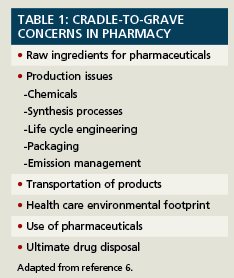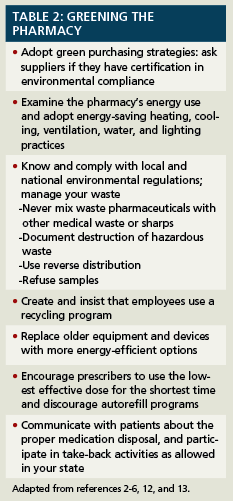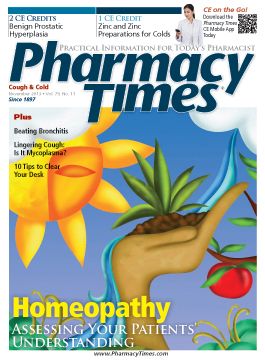Getting to Green: How's Pharmacy Doing?
It's time to minimize pharmacy's environmental footprint.
It's time to minimize pharmacy's environmental footprint.
Green is the new black, and with good reason. America’s landfills are overflowing, only two-thirds of our waters are fishable and swimmable, and human habits are ruining other species’ habitats. It’s time—past time—to think about minimizing our environmental footprint.1 The health care industry has a critical role in decreasing carbon emissions. Medical facilities use almost twice as much energy per square foot as traditional office spaces do, contributing up to 8% of the carbon footprint in developed nations.2-4 Additionally, increasing environmental stress such as air pollution and inadvertent toxin exposure creates illness—increasing demand for health care. It’s a vicious cycle.4
Issues Specific to Pharmacies
Since the mid-1990s, environmentalists have tried to wrestle our attention from looking at only the consequences of our actions, which address a small portion of our overall impact, to looking at entire processes.5 This approach, called cradle-to-grave (C2G) stewardship, or regenerative design, looks at products’ and services’ entire life cycle to determine the best way to ensure that future generations will be unharmed by our actions. In practice, it means creating an environmentally friendly supply chain that uses recycling, reclamation, remanufacturing, and reverse logistics.2,6 Table 1 lists pharmacy’s C2G concerns.
The pharmaceutical life cycle includes all actions and outcomes related to raw materials (including excipients), synthesis, manufacturing, use, and after-use environmental presence. To be green, we need to eliminate or significantly decrease hazardous substance use and improve environmental, safety, and health impacts through the process.2,6

The Industry
The US pharmaceutical industry has taken well-documented steps to green its products and processes.3,7,8 One silver lining of using green manufacturing processes: products taste and smell better. Another benefit is the development of therapies that target specific functions, reducing toxicity and side effects. And, green chemicals are safer for the chemists who use them.9,10
Manufacturing emissions are another concern. Industrial emissions tend to be lower in North America and Europe compared with other parts of the world, due to regulations and monitoring. A growing concern, however, is that globalization has moved the manufacture of many pharmaceuticals to Asia, South America, and Africa. In some of those locations (especially India and China), manufacturers have ignored factory emissions and effluent run-off pollution, exposing neighboring residents to potentially dangerous situations.6
Packaging material creates additional trash. In the 1950s, most pharmaceuticals were available in bulk packaging, then dispensed in vials. Today’s multi-million dollar packaging industry uses elaborate packing and advertising for relatively small quantities of pharmaceutical agents.11 Although there are no exact and reliable data available on the share of unused but sold pharmaceuticals, traditionally approximately 10% to 35% of manufactured medication and its associated packaging has been wasted. Pharmaceutical manufacturers are addressing this by trying to identify package sizes that minimize unnecessary packaging and outdated products.6
Distributors
Medication distribution requires large amounts of energy used to transport and store medication properly. The most environmentally responsible distributors look at their entire processes and choose storage and transportation methods that are the cleanest possible. Some have relocated to more accessible locations to reduce transportation costs.5 Many now deliver not only products, but information about their characteristics and disposal methods. They also establish reverse distribution programs that allow pharmacy retailers and hospitals to return unused or expired products easily.6
Pharmacies and Health Care Facilities
American health care facilities devour energy, second only to the petrochemical industry. Health care expenditures top $8.5 billion annually, and 62% of the waste health care sends to landfills is recyclable or compostable.4 Part of our problem is simply awareness: many health care professionals persist with outdated practices, mind-sets, and behaviors.3
Surprisingly little information is available about hospital and retail pharmacies’ steps toward greater environmental awareness. Some strategies are listed in Table 2. Many pharmacies have failed to take a simple step: placing and using recycling bins for the copious amounts of waste we create.

Patients
Disposal of unused, unwanted, or expired pharmaceuticals and personal care products (PPCPs) is a specific yet poorly elucidated concern. Scientists have identified trace amounts of active pharmaceutical ingredients (APIs) in aquatic environments, wastewater biosolids, and treated drinking water.6 PPCPs find their way into water when they are flushed down the toilet, seep from landfills, or remain in sewage treatment plant (STP) effluent water; most American STPs cannot remove all drugs from sewage.6,12
Many municipalities now ask residents to use disposal mechanisms such as take-back programs that route unwanted PPCPs to an incinerator rather than a landfill because high-burn temperatures and effective emission-control systems almost eliminate PPCPs from our environment.2,12 If patients returned 50% of excess PPCPs to a take-back pharmacy and disposed of 50% in the trash, current API residue would be reduced by 93%.8
Patients are becoming more aware of the impact their PPCPs have on the environment, but still use outdated and dangerous disposal methods.5 Pharmacists and their associations can increase awareness. For example, the Michigan Recycling Coalition recently identified pharmaceuticals as an area of concern and received a grant to educate consumers. Partnering with the Michigan Pharmacists Association (MPA), they presented a well-received program focusing on strategies currently identified or in use that eliminate medications from seeping into the watershed.
Larry D. Wagenknecht, FMPA, FAPhA, chief executive officer at MPA, spoke about MPA’s take-back program. In a recent 3-hour window, they collected 579 pounds of raw materials (ie, stripped of packaging) with a commercial value of more than $1 million. From that exercise, they identified activities that appear to create waste. One is autorefill systems often used by mail order pharmacies. Wagenknecht says, “Many of the prescription drugs we collected had been sent automatically, despite the fact that the patient didn’t need the prescription. Discouraging autorefill programs could significantly reduce waste.”
Final Thought
Ultimately, we need to encourage reduced pharmaceutical use—commonsense approaches like using prevention rather than treatment.6,9 Ultimately, the solution to sustainability will require all of us to incorporate environmental awareness into our daily practices.
Ms. Wick is a visiting professor at the University of Connecticut School of Pharmacy and a freelance clinical writer
References
1. EPA’s Lisa Jackson on water quality challenges. July 18, 2012. http://earthfix.opb.org/water/article/us-epas-top-administrator-lisa-jackson-talks-about/. Accessed June 13, 2013.
2. Daughton CG. Drugs and the environment: stewardship & sustainability. National Exposure Research Laboratory, Environmental Sciences Division, US EPA, Las Vegas, Nevada, report NERL-LV-ESD 10/081, EPA/600/R-10/106, 12 September 2010, 196 pp. http://www.epa.gov/nerlesd1/bios/daughton/APM200-2010.pdf. Accessed June 1, 2013.
3. Pinzone M, Lettieri E, Masella C. Sustainability in healthcare: combining organizational and architectural levers. Int J Eng Bus Management. 2012;4:1-9.
4. Rajagopalan S. Healthcare without harm: diagnosing the carbon footprint of healthcare. www.slideshare.net/FrostandSullivan/healthcare-without-harm-diagnosing-the-carbon-footprint-of-healthcare. Accessed June 1, 2013.
5. Xie Y, Breen L. Greening community pharmaceutical supply chain in UK: a cross boundary approach. Supply Chain Management. 2012;17:40-53.
6. Kummerer K, Hempel M. Green and sustainable pharmacy. Berlin Heidelberg; Springer-Verlag: 2010.
7. Pheub K-J. Greening of pharma marketing. Pharm Executive. 1992;12:50-56.
8. Cook SM, VanDuinen, Love NG, Skerlos SJ. Life cycle comparison of environmental emissions from three disposal options for unused pharmaceuticals. Envr Sci Tech. 2012;46:5535-5541.
9. Cue B, Manley J. A greener prescription. Chem Engineer. 2007:52-54.
10. deBraal H. Sustainability in green pharmaceutical production. Pharm Technol Eur. 2009:39-42.
11. Stweart A. Sustainability education, or educating sustainably? eCULTURE. 2009;2:147-154.
12. Morse C. Pharmaceutical waste management: compliance with environmental regulations. Drug Topics. http://drugtopics.modernmedicine.com/drug-topics/news/modernmedicine/modern-medicine-feature-articles/pharmaceutical-waste-management-com. Accessed June 1, 2013.
13. Kummerer K. Pharmaceuticals in the environment. Annu Rev Environ Resour. 2012;35:57-75.

